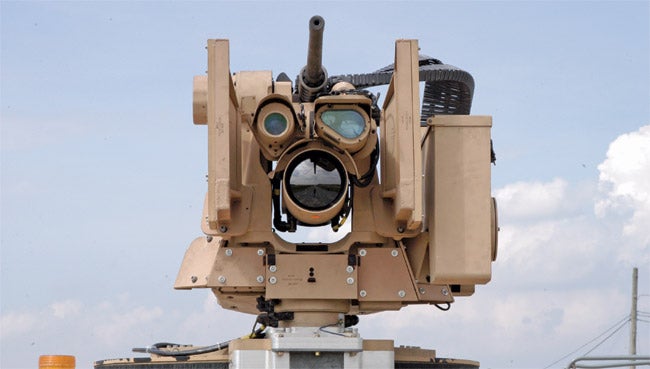The reserve component of the U.S. Army will begin receiving the XM153 Common Remotely Operated Weapon System (CROWS) this year in bulk issue. Last year ten Army Reserve units received the remotely controlled mounted weapon system, but due to supply and logistical issues the rest of the Reserve’s vehicle fleet slotted to receive it didn’t get it and will be getting it this year. Beginning with units in Arkansas, New Jersey and South Carolina and then continuing on throughout the Reserves.
The first Soldiers to receive the CROWS in the Army were Infantry and Stryker Brigade Combat Teams. The system is so versatile that it can be mounted on nearly any vehicle with a turret: Humvees, large trucks, tanks, watercraft and more. It’s also compatible with the M2 .50-cal machine gun, the MK19 automatic grenade launcher, the M240B rifle and the M249 squad automatic weapon. It comes with a large ammo box able to feed a massive amount of firepower into the weapon: 96 rounds for the MK19, 400 rounds for the M2, 1,000 rounds for the M240B and 1,600 rounds for the M249.
“That’s a lot of rounds you can put down range,” said Moe.
The fielding is managed by PM Soldier Weapons, a program that specializes in developing and procuring new technology to Soldiers.
“It’s going to improve the accuracy of how we fight. It’s going to reduce the number of casualties that the Army takes. It’s going to improve on our accuracy of finding the enemy,” said Arquelio Gillespie, fielding manager for the Materiel Fielding & Training Team for the Tank Automotive Command.
There was a bigger push to put CROWS on turrets in Iraq and Afghanistan from 2005 to 2009. These units, however, were intended for temporary use. Soldiers turned them back in as they returned home. Shortly after, however, the CROWS became what is known in the logistics world as a “program of record,” meaning it was approved as an official weapon assigned to units long-term.
This means all of the benefits the CROWS has to offer are here to stay and improve the Army Reserve for the long haul.
For those unfamiliar with the CROWS, give this introduction video a watch, it summarizes the system very well. Essentially it is a gun turret remotely controlled by an operator from the inside of the vehicle. It can be cocked, maneuvered, aimed, fired, even changing out ammunition sources and fixing malfunctions all from a computer screen inside the vehicle. From talking to Soldiers in Camp Leatherneck, I’ve heard that it also has an integrated shot detector that can swivel the entire system to face a threat just from where the shots are fired from. It can account for movement, so Soldiers can hit a moving target or they can hit a stationary target while the vehicle is in full motion, with the machine accounting for the variables.
Honestly I’ve very torn on the CROWS. Having been in combat as a turret gunner for a large number of mounted missions, I can certainly attest to the vulnerability of being in a turret. It can be extremely unsafe during vehicle roll overs or IEDs and we’ve lost a number of turret gunners, both Army and Marines from these accidents. To a well trained shooter, a turret gunner is an excellent target, much more so in the earlier Iraq days when the up-armored Humvees didn’t exist. Even with the additional armor protection there were two Marines from my company that took rounds to the Kevlar while operating in a turret gunner capacity on mounted patrols.
However, I can also attest to the advantages of having a live human in the turret. Many times these turret gunners provide a set of eyes and ears that a buttoned up tactical vehicle wouldn’t otherwise have. They can hear, see, sense, even take in the smells of an area of operations while on patrol and provide valuable feedback to the crew. An open turret also provides an excellent avenue of escape because it is open and can be crawled out of during a vehicle roll-over. More importantly these gunners can get a visual of the terrain the vehicle is traversing. On one particular occasion when I was a vehicle commander, we were about to lead the convoy down what appeared to be a simple bump in the landscape. But my turret gunner quickly yelled down to us that what appeared to be a bump, was actually a five foot drop! He was able to see this because he was so high in the air.
 Your Privacy Choices
Your Privacy Choices
